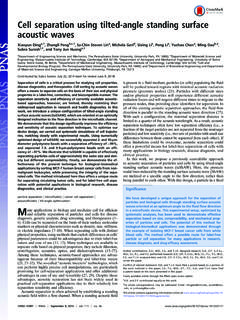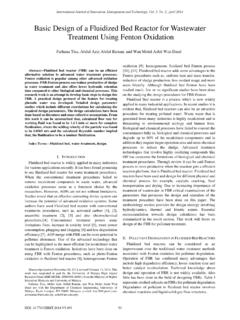Transcription of Design Considerations for Sulphuric Acid Plants
1 1 Design Considerations for SulphuricAcid PlantsShort CourseSulphuric acid Production TechnologiesPresented byDouglas LouieCobre-Copper 2010 Hamburg, GermanyJune 6-10, 2010 Contact InformationDouglas LouieWorleyParsons CanadaMinerals and Metals2645 Skymark AvenueMississauga, OntarioL4W 4H2 Canada905 212 2010, Hamburg, Germany, June 6-10, 2010 Course ObjectiveProvide an overview of Design Considerations for the Sulphuric acid plant equipment and an awareness of available optionsDiscussion on plant energy consumptionOptions for treating gases from batch smelting processes3 Cobre-Copper 2010, Hamburg, Germany, June 6-10, 2010 Course OutlineGas Cleaning - Quench System- Gas Scrubbing- Gas Cooling - WESP sContact Section- Blowers- Converters- Gas-to-Gas Heat ExchangersStrong acid System- Towers- Packing Supports- Packing- Distributors- acid CoolersElectrical Power ConsumptionBatch Processing4 Cobre-Copper 2010, Hamburg, Germany, June 6-10, 2010 Gas CleaningWaste gases from the metallurgical processes must be treated to reduce the sulphur dioxide emissions to the atmosphere.
2 To achieve this the sulphur dioxide in the gas is converted to sulphur trioxide for the production of Sulphuric acid in the Sulphuric acid plant. The metallurgical off-gases must be cleaned prior to entering the contact section of the acid plant to enable the plant to produce a product acid of acceptable quality for use and sale. Clean gas is also required for the proper operation of the plant. Prevent plugging of catalyst and subsequent increase in pressure drop Prevent poisoning of the catalyst Prevent corrosion of acid plant equipmentPrimary contaminants in the gas are: SO3, dust, metals, mercury, selenium, arsenic and fluorides, 2010, Hamburg, Germany, June 6-10, 2010 Quench SystemThe function of the Quench System is to: Adiabatic saturation and cooling of the incoming gas Partial cleaning of the gas Provide residence for the condensation of metallic vapours and growth of the particles to facilitate their subsequent removal in downstream equipment Reduce gas temperature sufficiently such that materials of construction can be changed to Fibreglass Reinforced Plastics (FRP)
3 And thermoplastics6 Cobre-Copper 2010, Hamburg, Germany, June 6-10, 2010 Quench SystemDifferent types of quench , radial flow scrubbers, venturi scrubbers and DynaWave systems can be used to quench the gas inlet of the quench tower is a high maintenance area if it is not designed properly and materials have not been specified properly. The process conditions in the gas inlet area vary from hot dry gas to wet cold conditions. Materials can be specified for hot dry gas conditions but these materials are not suitable for wet cold conditions and vice versa. In most quench tower designs, there is no clear interface between the two conditions so the area is subject to brick failure and the interface between hot/dry and cold/wet can be clearly delineated through proper Design of the gas inlet, maintenance in this area will be greatly 2010, Hamburg, Germany, June 6-10, 2010 Quench SystemDesign Considerations /ParametersSuperficial Velocity: 10 to 15 ft/s (3 to m/s) (open quench tower Design )Liquid to Gas Ratio: 15 to 20 USGPM/1000 ACFM (2 to m3/1000 m3)Residence Time.
4 If the off-gas contains large amounts of metallic fumes a minimum residence time of 3 seconds is recommended to allow for condensation of the fume and growth of the particle that will allow the impurities to be removed in downstream scrubbing the off-gas does not contain metallic fumes, then any gas-liquid contact device can be Water: In the event of a failure in the quench circulating system, emergency water is required to reduce the gas temperature and protect downstream equipment until the plant can be safely shutdown. Emergency water must come from an uninterruptible Fumes: Arsenic, SeleniumEmergency Water: Usually an elevated head tank with sufficient capacity to supply water for the time it takes to safely shutdown the plant.
5 The tank needs to be high enough to provide sufficient head/pressure to the spray nozzles. A possible alternative is a firewater system which typically is equipped with emergency back pumps/systems to ensure water is always : Gleason, T., Scrubbing of Volatile Compounds in Wet Gas Metallurgical Systems , Symposium on Trace Metals in Non-ferrous Metallurgy, The Metallurgical Society of 2010, Hamburg, Germany, June 6-10, 2010 Gas ScrubbingMany devices are available for scrubbing and cleaning the gas. The choice will depend on the amount and nature of the impurities. Fixed or variable throat venturi scrubber Radial flow scrubber Peabody scrubber Packed tower DynaWave reverse jet scrubberMany devices are available for scrubbing and cleaning the gas.
6 The choice will depend on the amount and nature of the selection of a scrubber will depend on dust loads and the particle gas flow varies a lot a variable pressure drop device is recommended so that gas cleaning efficiency can be maintain throughout the range of gas flows. Materials of construction will depend on the gas temperature andcomposition of the weak acid . Generally, FRP and thermoplastics are specified. In some cases, rubber lined steel or stainless steel can be 2010, Hamburg, Germany, June 6-10, 2010 Gas ScrubbingIn general, there is an operating cost/penalty for achieving higher scrubbing efficiencies in terms of the pressure drop across the Considerations : Plugging TurndownDynaWave Characteristics- Turndown: 2:1 with no loss in efficiency- Energy consumption of system is split between gas side pressure drop and liquid pumping energy- No moving parts- Large diameter nozzles are not easily pluggedVenturi Scrubber Characteristics- With variable throat, efficiency can be maintained through a wide turndown- Energy consumption is primarily in gas side pressure drop10 Cobre-Copper 2010, Hamburg, Germany, June 6-10, 2010 Gas CoolingPurposeCool the process gas to condense sufficient moisture from the gas to meet the plant water Water BalanceThe amount of SO2and water entering the Sulphuric acid plant must be in the correct proportions or balance in order to produce Sulphuric acid of the desired Water BalanceAcid is made up of SO3and water.
7 In a sulphur burning plant, a small amount of water comes in with the atmospheric air required for sulphur majority of water is added as dilution water in the absorber a metallurgical or regeneration acid plant, considerably more water enters the contact section of the acid plant with the gas exiting the gas cleaning system. If there is too much water in the gas or the SO2concentration is low, the proportion of water to SO3that is produced may be too high to produce the acid at the desired plant water balance is the point at which the incoming water meets the exact requirements for producing acid at the desired strength. If the plant is not in water balance, the desired product acid concentration cannot be maintained and will 2010, Hamburg, Germany, June 6-10, 2010 Gas CoolingTwo basic ways to cool the gasIndirect Cooling Indirect gas cooling is generally done in some type of heat exchanger, the most common being vertical shell and tube condensers cooled by cooling Cooling Direct cooling of the gas involves contacting the gas directly with the cooling medium.
8 This is generally done in a packed or tray tower with weak acid as the cooling 2010, Hamburg, Germany, June 6-10, 2010 Gas CoolingDirect Cooling Packed Cooling Tower Tray Scrubber Open Spray Tower Cyclone CoolerDirect cooling systems require a weak acid circulation system and weak acid coolers (typically plate and frame heat exchangers). Direct cooling involves two temperature Cooling water and weak acid temperature approach in the weak acid Weak acid and gas outlet temperature approach in the cooling approach temperature at the top of the cooling tower is C (3 F).13 Cobre-Copper 2010, Hamburg, Germany, June 6-10, 2010 Gas CoolingIndirect Cooling Vertical shell and tube heat exchanger Star cooler Graphite coolers Calorplast heat exchangerIndirect cooling systems avoid the need for a weak acid circulating cooling involves only one temperature Cooling water and process gas temperature approach in the heat closer the temperature approach, the larger the heat 2010, Hamburg, Germany, June 6-10, 2010 Gas Exit Gas Cleaning System (oC)Sulphur Dioxide Concentration (%vol) Overall ConversionThe barometric pressure has an impact on the partial pressure of water in the gas and the operation of the gas cooling system.
9 At the same temperature, gas at a lower absolute pressure will contain proportionally more water than gas at a higher absolute will be more difficult for a plant located at high elevation to meet the plant water balance than a plant located at sea 2010, Hamburg, Germany, June 6-10, 2010 Gas CoolingPacked Cooling Tower Sizing and DesignPacking: 75 mm (3 ) Polypropylene saddlesTripaksSizing: Based on pressure drop and flooding considerationsTypically superficial gas velocity in the range of to m/sLiquid Flow: 15 to 45 m3/h per m2cross-sectional areaSubject to pressure drop and flooding Considerations andthe tower heat load Materials of Construction: Typically fibreglass reinforced plastic (FRP)Dual LaminateSome Plants will use mechanical chillers to obtain colder water temperatures for cooling so the plant water balance can be 2010, Hamburg, Germany, June 6-10, 2010 Wet Electrostatic PrecipitatorsTo produce a clean gas that will be fed to the acid plant for the production of Sulphuric acid .
10 Removing dust Removing condensed metal fumes Removing acid mistMist precipitators are the final line of defense against admission of impurities to the acid plant and must always be kept operating at peak GEA Bischoff Outotec/Boliden Beltran Hugo Petersen FLSmidth Airtech Southern Environmental Others17 Cobre-Copper 2010, Hamburg, Germany, June 6-10, 2010 Wet Electrostatic PrecipitatorsCollection Efficiency = 1 - (- A/V)Deutsch Equation: Collection Efficiency = 1 - (- A/V) - Migration VelocityA - Collecting AreaV - Gas FlowThe migration velocity is the average velocity at which the charged particle travels to the collecting electrode. The amount of electrical charge that can be placed onto a particle is a function of the size of the particle, gas properties, electrical, chemical and physical properties of the particle as well as the Design of the discharge electrode.







